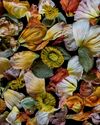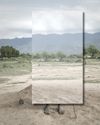
After facing the misery, the harsh reality, and the unhappiness, she couldn't bear the superficial and vacuous life as a model. Traveling to these unfortunate countries changed her point of view on life. As a way to free her soul to a different road, she started to focus on creating Art.
From now on, Adriana Soares will express herself through photography, paintings, poetry, writing (she published ten books), and journalism to tell everybody about other people's lives and the painful path regarding her own life. She distinguishes herself thanks to the production of a massive photographic work of Fashion and Art. She is an artist with a restless soul. She makes a name for herself in painting panorama.
She is creating innovative photo paintings that excite and surprise people and help her tell her story showing a multi-faceted interiority rich with profound meanings.
Soares' work has been featured in galleries and museums along with several successful exhibitions in the past few years.
This creative dynamism has generated a partnership between Art and Finance with Banca Generali Private, which promotes her Art through a series of exhibitions and events. Her work has been featured in a personal collection at the Macro Museum in Rome - Archetypes, Soul Dna.
This story is from the October 2020 edition of Lens Magazine.
Start your 7-day Magzter GOLD free trial to access thousands of curated premium stories, and 8,500+ magazines and newspapers.
Already a subscriber ? Sign In
This story is from the October 2020 edition of Lens Magazine.
Start your 7-day Magzter GOLD free trial to access thousands of curated premium stories, and 8,500+ magazines and newspapers.
Already a subscriber? Sign In

IN THE SHIPYARDS OF DHAKA
A very large shipyard in Dhaka is located on the Buriganga River's banks, directly across Dhaka's old city.

Aga Szydlik INDIA
A JOURNEY INTO THE LAND OF DIVERSITY, CULTURE, AND COLORS

SEBASTIAN PIÓREK EXPLORING Enjoyable LANDSCAPE
I retrieved the idea of nature closely linked to the field of human feelings.

JEAN KAROTKIN GYMNOPEDIES
Gymnopédies, Karotkin's ongoing series of botanical portraits, takes its name from a trio of piano compositions by 19th-century French composer Erik Satie.

BUTTERFLIES IN LOVE WITH FLOWERS
I sometimes think Chinese art is not fully appreciated in the West. I was exposed to it growing up in Australia, although my fascination was more with calligraphy.

Lissa Hahn:
Hahn: HOW TO EVOKE A PAVLOVIAN RESPONSE IN HUMANS

The Art of DISAPPEARING
In the classical proposal, indigenous people are usually the topic of discussion, but rarely do they have a hand in shaping it.

AGING SINGAPORE
A PHOTOGRAPHY EXHIBITION

An Exclusive Interview With Brice Gelot
"Nothing's more interesting than reality. So from rough areas that never see tourists to poor neighborhoods where I can find chaos, I find beauty. I let the street speak, and I just document what I see...”

Mark Edward Harris: Wabi-sabi and the Japanese Aesthetic
"From the 6th century until the introduction of the Gregorian calendar in 1873, Japan used a variation of the lunisolar Chinese calendar that was divided into 24 seasons. These mini-seasons were determined by the phases of the moon, the rise of the tides, and other natural phenomena. Living in constant contact with their surroundings - the mountains, the ocean, and their all-important rice fields - people were acutely aware of even the smallest changes in their environment and often celebrated them with "matsuri" (festivals).